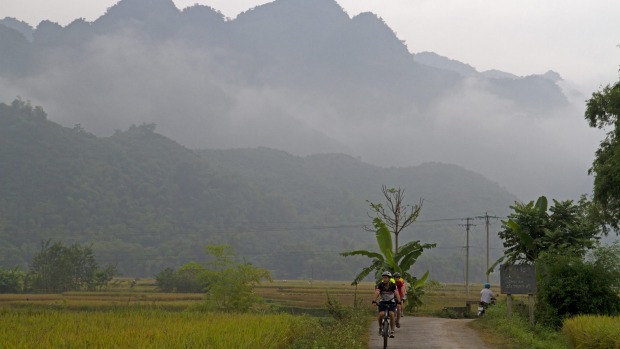
I could be nowhere but Vietnam. In the rice fields, farmers stand thigh-deep in water, their conical hats dotting the land like distant full moons. Faces rise as we cycle past. Shy smiles greet us then disappear behind hats again as the harvest continues.
Between the fields run the levees that partition the land into terraces, and atop them are the stalk-thin paths that this day double as our cycling tracks.
Vietnam is one of the most popular cycling destinations abroad for Australians, but to ride here can often mean dicing with a typically Asian storm of traffic. On these rice terraces near Mai Chau, however, there's not a vehicle in sight. Instead, cows wander the tracks, chickens dash across them and a man herds a flock of ducks towards home.
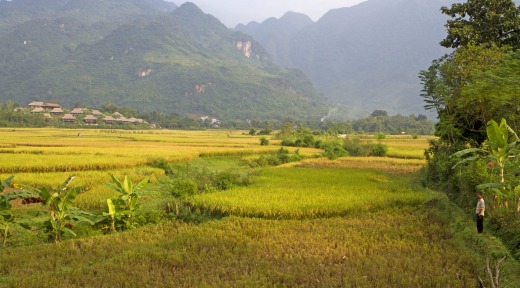
About three hours' drive west of Hanoi, the town of Mai Chau is a snaking line of blue walls and red roofs sunk deeply into a valley. Limestone hills rise to numerous dome-like peaks around the valley, and a perpetual haze hangs like a cataract over the town and its surrounding rice terraces.
For two days we'll cycle through this most quintessential of Vietnamese landscapes, before parking our bikes to head on foot through the dreadlock-thick jungle of the country's oldest national park.
The cycling isn't point-to-point. We're pedalling for pleasure rather than linear travel.
Andrew Bain
The cycling isn't point-to-point. We're pedalling for pleasure rather than linear travel, radiating out each day from a homestay in Pom Coong, a White Thai village a few hundred metres from Mai Chau. Accommodation is basic - mattresses laid out on the floor of a stilt house - but there's Wi-Fi, views over a sea of rice, and a cold beer at the end of the riding day.
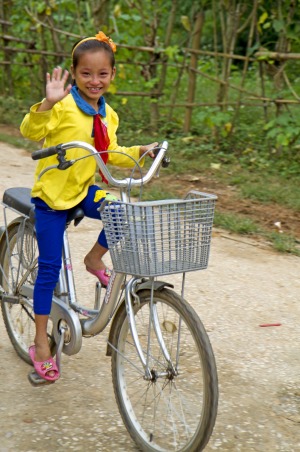
Days begin with the standard Asian rural alarm - the crowing of roosters across the valley long before first light. Dawn mist merges with the smoke of burning rice stubble in the fields, with Mai Chau's farmers already hard at work.
Our rides start on single-track paths across the rice levees, our wheels skidding and sliding through mud after morning rain. There's barely a hill or bump to pedal over as we curl through valleys that intersect like puzzle pieces. We ride at the foot of the mountains - impenetrable jungle rises up the slopes to one side and groomed rice fields flood through the valleys on the other.
Thin lines of villages fill the fold between plains and mountains, and every one of them seethes life. Roosters, hens, chickens, children, dogs and puppies scuttle about. Old ladies burst into betel-nut grins, and school kids on single-gear bikes race to keep up with our 27 gears. The stilted homes are hung with both laundry and TV satellite dishes.
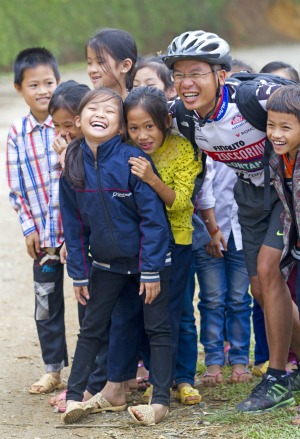
Even more striking than the landscape is its use, with every sliver of unforested land arranged and cultivated into edible order. Gardens, roadsides and any sundry parcels of dirt sprout rice, cassava, corn, taro, bananas, papaya or bitter melons. It's like riding through an outdoor grocery.
Over it all hangs a poultice of humidity, the discomfort alleviated by the movement of the cycling, or by the shade of the rare stands of forest, where clumps of bamboo rise like giant stalks of broccoli. Sun peeps through the haze, painting the rice fields yellow. By day's end it feels as though we've been everywhere and nowhere - so much activity and life, and yet we've never been more than a few kilometres from our homestay.
From Mai Chau, it's a 120-kilometre drive southeast to Cuc Phuong National Park, but we aren't doing the journey entirely by bike. In the early morning we pack our bikes into the back of a truck, and later drive up and out of the valley, meeting our wheels again 25 kilometres from Mai Chau.
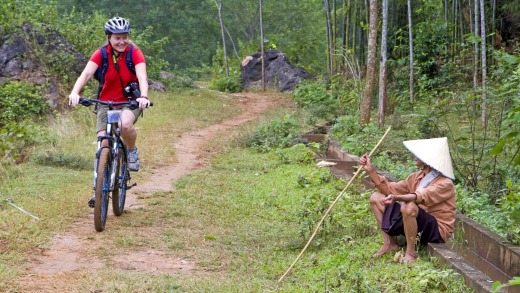
For a final couple of hours we will ride, leaving behind all traces of a tourism industry. Into a minor valley stretching between main roads, we pedal towards the national park, though the destination suddenly seems secondary. The beauty here is not in rice fields or jungle; it's in the wide-eyed welcome of the people along this road that so rarely sees passing tourist traffic.
It's an undulating 30-kilometre ride through a valley of cane and cassava rather than rice, but still I think I expend more energy waving to and high-fiving children as they dash out of homes, schools and lanes.
At one point an entire classroom of kids surrounds us. Growl teasingly at the children and they sprint away screaming in delight. Seconds later they're back. Even when we pass a funeral procession, there are grins in greeting.
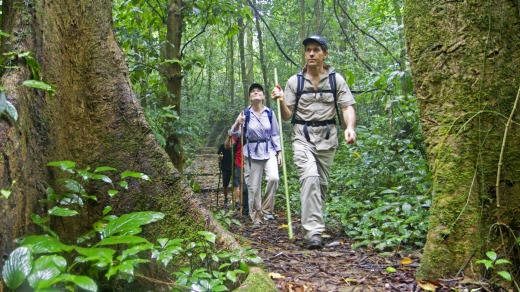
As the road merges into the highway again, we pack our bikes back in the truck and drive on to Cuc Phuong.
This 222-square-kilometre national park was declared in 1962, in the midst of war, becoming the first of the country's 30 national parks. Encompassing two limestone ranges consumed by jungle, it's one of the most popular national parks in the country, drawing around 80,000 visitors a year.
At its entrance sits a creaking, cracking colonial guesthouse, where at dawn I'm woken by the calls of gibbons sounding through the jungle like car alarms.
A few hundred metres from the guesthouse are two of the park's prime conservation resources: the Endangered Primate Rescue Centre and the Turtle Conservation Centre.
Cuc Phuong has only five native species of monkey, but there are 26 species throughout Vietnam. The primate centre contains 16 of the species, buying animals from poachers in markets and rehabilitating them for release back into the wild.
But the real treasures at Cuc Phuong are wild and can only be seen on foot. From the centre of the park, a six-kilometre trail loops out to the Thousand Year Old Tree and it's here that we begin our day of walking.
Entering this jungle is like taking a step back into prehistory. The plant life is rampant, with trees growing over trees, which grow over trees. Stand still for a few minutes and it feels as though the jungle might also devour me.
Butterflies dance through the thick, humid air, which is otherwise as still as a painting, and the night's rain drips through the canopy long into the day.
The limestone ranges are riddled with caves - among them have been found the oldest remains of the Viet people - and we veer away from the main trail to enter Palace Cave, where old stalactites and flowstone formations hang like teeth from the roof.
A short walk on, we come to the Thousand Year Old Tree, an ancient oak forked into three separate trunks. In a jungle containing about 2400 different plant species, this tree remains the true giant, its trio of trunks angling out of the ridge.
At the trail's end, a little-used path detours away to the Muong village of Khanh, 16 kilometres away at the national park's edge. It's a trail that can only be walked with a park guide.
Our guide, Pham, has the mild, bureaucratic look of a librarian, but the jungle smarts of a survival manual. If a tree or bush stirs, he knows instinctively which animal is causing it. Sometimes nothing moves and Pham still stops. "Mantis," he announces, pointing to a leaf and a brilliantly disguised insect a few metres from the trail.
Less than 1 per cent of visitors to the park - about 250 people - hike this trail to Khanh, and Pham walks at the head of our group, chopping with his machete at the bush that consumes sections of the path.
Six kilometres from Khanh we step out into a clearing where, until the 1990s, around a dozen Muong people made their home. We walk through forgotten rice fields before finally looking down on the rooftops of the village.
Khanh has a stunning setting at the edge of a narrow valley filled with sugar cane, cassava and crops. The busy Ho Chi Minh Highway roars past unseen, just a couple of kilometres but seemingly centuries away.
In the village we'll once again sleep in a basic homestay, but after eight hours of hiking through the humid jungle, the thin mattress on the floor will be a bed as good as any in the world.
I'm mud splattered, my ankles are bloodied from leeches, and when I look back at the mountain slopes, they're an unruly Afro of trees, plants and vines. It looks impenetrable, and yet we've somehow just been through it.
TRIP NOTES
MORE INFORMATION
vietnamtourism.com
GETTING THERE
Vietnam Airlines flies daily to Hanoi from Sydney and Melbourne, transiting through Ho Chi Minh City; see vietnamairlines.com. Australians require a tourist visa to enter Vietnam. Download application forms at vietnamembassy.org.au.
SEE + DO
World Expeditions runs an 11-day Bike, Hike and Kayak Northern Vietnam trip, which includes a couple of days cycling around Mai Chau and a hike through Cuc Phuong National Park. The trip costs $2270 a person. See worldexpeditions.com.
FIVE VIETNAM NATIONAL PARKS
HOANG LIEN
Encompasses Vietnam's highest mountain, the 3143-metre Fansipan.
CAT BA
Island reserve at the heart of Halong Bay with monkeys, birds, caves and hiking trails.
BAI TU LONG
Immediately north of Halong Bay, it's a carbon karst copy of its famous neighbour, but without the crowds or the infrastructure.
CAT TIEN
Northeast of Ho Chi Minh City, with good hiking and mountain biking and rare wildlife, including the Javan rhino.
BACH MA
Covering both coast and mountains, this central park includes 1450-metre Bach Ma Mountain. If you get a view from the summit, be grateful - it's one of the wettest places in the country.